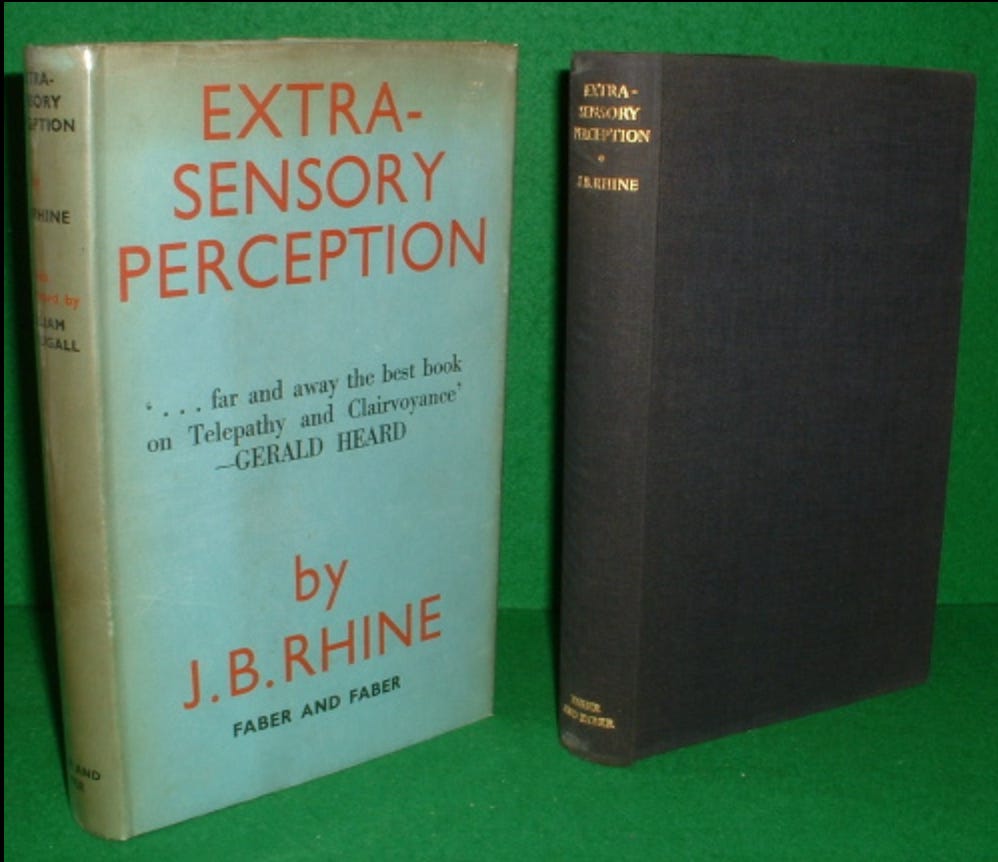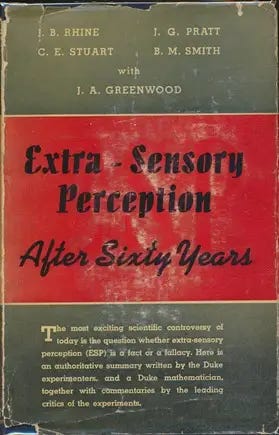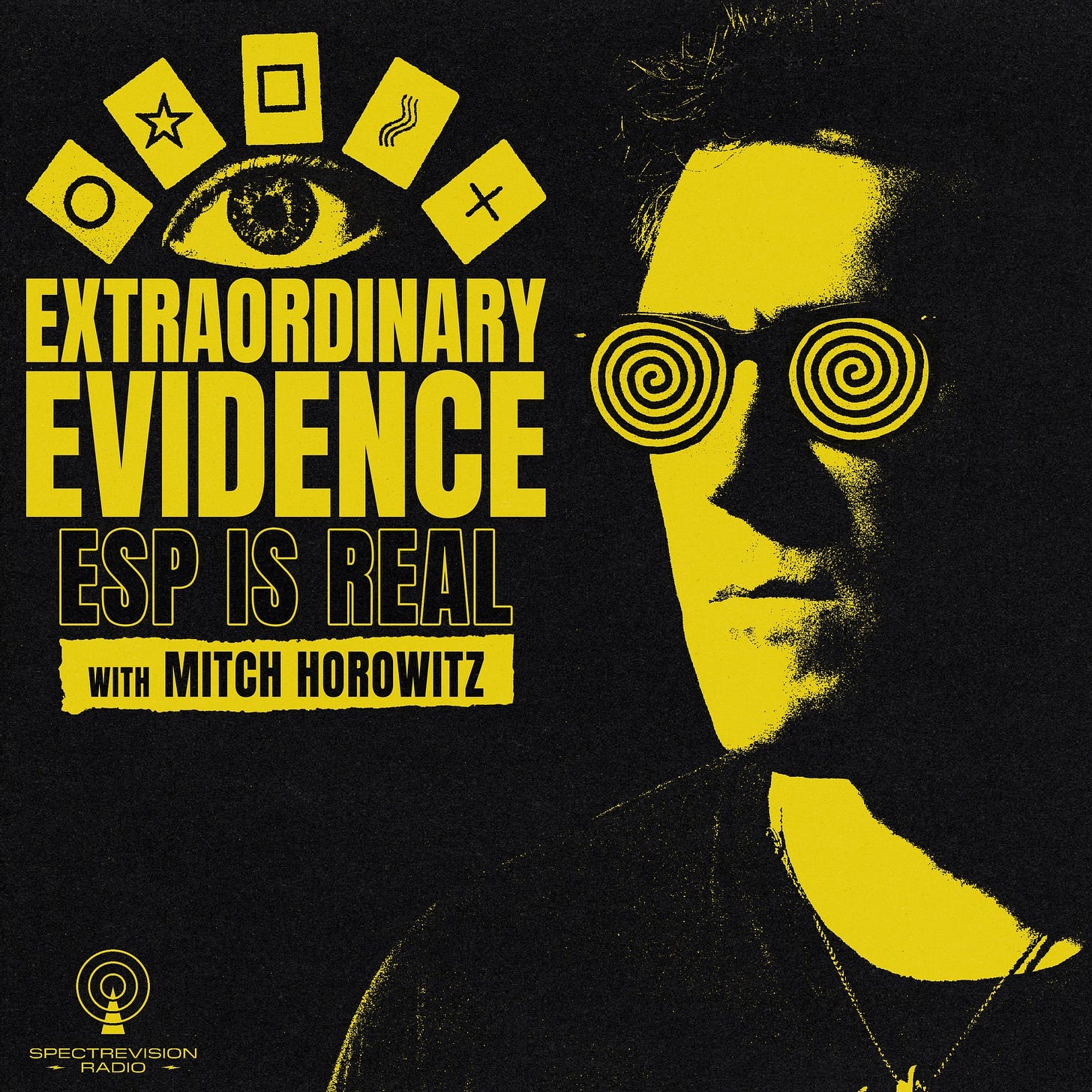The Scientist Who Proved the Impossible
Reconsidering J.B. Rhine on the ninetieth anniversary of the Parapsychology Lab
This year marks ninetieth anniversary of Duke University’s Parapsychology Laboratory, founded in 1935 by husband-wife scientists J.B. and Louisa Rhine. The Rhines’ efforts not only established psychical research as an accepted, if controversial, academic science but their work simply, seismically, and repeatedly established clinical evidence for Extrasensory Perception, the title of J.B.’s pioneering 1934 monograph.
As a book, Extrasensory Perception is, in my view, one of the most important, if inversely under-read, studies of the twentieth century. Its data demonstrating an extraphysical aspect to the psyche—despite prejudicial blowback on Wikipedia and in academic letters and social sciences (less so in hard sciences)—has proven replicable, demonstrable, and statistically bulletproof. In short, the cofounder of Duke University’s Parapsychology Lab proved the impossible: ESP is real.
J.B. and Louisa trained as statisticians and botanists at the University of Chicago where both received doctorates, a considerable rarity for a woman then. In the 1920s, botanists were at the forefront of statistical theory. While at Chicago in 1922, they were inspired by a talk on Spiritualism by Sherlock Holmes author Arthur Conan Doyle. Although taken by Doyle’s “utter sincerity,” J.B. later feuded with the writer over deceptions by one of Doyle’s favored mediums. With J.B.’s eyes on greater horizons, he soon grew restless in his chosen career.
“It would be unpardonable for the scientific world today to overlook evidences of the supernormal in our world,” J.B. told what must have been a mildly surprised audience of scientific agriculturalists in spring of 1926 at the University of West Virginia, where he held a teaching position.
The Rhines began casting around, venturing to Columbia University and Harvard, seeking opportunities to combine their scientific training with the metaphysical interests that had ignited their relationship as teens. Odd jobs were necessary to stay afloat.
“I think, too, we are tiring of chasing the Psychic rainbow or the Philosophic pot of gold,” J.B. wrote in his notes in January of 1927. As often occurs in life, just prior to resignation following immense effort, an extraordinary—and in this case, historic —opportunity appeared.
The new chairman of Duke’s psychology department, William McDougall—who favored scientifically driven research of mental phenomena—brought the Rhines to Durham, NC, that fall. In 1930, McDougall made J.B. a formal part of the campus. Although the founding of Duke’s Parapsychology Laboratory is often dated to that year, J.B.’s program was not christened the Parapsychology Laboratory until 1935 (in 1929 he called his prototype the “Institute for Experimental Religion”), where it remained until 1965. Today, the Rhine Research Center functions as an independent lab and education center off campus.
At Duke, J.B. did not quite originate but popularized the phrase extrasensory perception, or ESP, which became a household term. The work begun at the Parapsychology Lab demonstrated that we participate in trackable, replicable patterns of extra-physicality that permit us, at least sometimes, to communicate and receive information in a manner that surpasses generally acknowledged sensory experience and means of data conveyance.
What evidence exists for my chin-out claims of science affirming the extra-physical? J.B.’s innovation as a researcher is that he wanted to develop simple, repeatable, and unimpeachable methods, with rigor and without drama or speculation, for testing and statistically mapping evidence for anomalous communication and conveyance. To facilitate this, he initially created a series of card-guessing tests that involved a deck called Zener cards designed by psychologist Karl E. Zener (1903–1964).
You may recall Zener-card tests affectionately lampooned in the opening of Ghostbusters. Zener cards are a five-suit deck, generally with 25 cards in a pack, with symbols that are easily and immediately recognizable: circle, square, cross, wavy lines, and five-pointed star. After a deck is shuffled, subjects are asked to attempt blind hits.
Probability dictates that across large spreads you are going to hit 20 percent, or one out of five, if you are operating from pure chance. But Rhine discovered, across literally tens and eventually hundreds of thousands of rigorously safeguarded trials (by 1940, the database included nearly a million trials) that certain individuals, rather than scoring 20 percent would score 25 percent, 26 percent, 27 percent, sometimes 28 percent—and in select cases a great deal higher. Rhine’s star subject, divinity student Hubert Pearce, once scored an “impossible” 25/25.
All data were reported. Nothing was withheld in the “file drawer.” No negative sets were excluded. At the time, social scientists commonly withheld negative sets on questionable grounds that something was flawed with the methodology. Rhine reversed this practice early on and led the overall social sciences to do so.
In a related landmark, the first modern meta-analysis, in which data from varied experiments are analyzed, validated (or identified as flawed), and statistically mapped, appeared in Rhine’s 1940 monograph, Extrasensory Perception After Sixty Years. The term “meta-analysis” itself was not coined until 1976.
Rhine also estimated how unpublished papers impact overall effects—this relates to the so-called file drawer problem or “publication bias” in favor of results, a common ethical lapse in the social sciences. “Such private information as can be assembled regarding unpublished work,” Rhine and his collaborators wrote in Extrasensory Perception after Sixty Years, “…shows that by a large majority, the unpublished reports are favorable to ESP rather than nonconfirmatory.” For many academic researchers, claims of ESP were more daunting than the opposite.
Partisanship around such findings is so intense—and sometimes purposefully obfuscating or confusing—that even well-intentioned lay seekers come away with the impression that Rhine’s work, or that of more recent parapsychologists, has proven unrepeatable or compromised.
Parapsychologist Charles Honorton (1946-1992), who died tragically young after a lifetime of health struggles, sought to analyze critical challenges to Rhine’s figures. In his 1975 presidential address to the Parapsychological Association, Honorton said:
Even among parapsychologists there is a rather widespread belief that most of the independent replication of the early Duke work were non-confirmatory and I suspect this may be especially true among those of us who were not around in the 1930s (which, incidentally, accounts for about three-fourths of the participants at this convention). In fact, I was surprised myself to find that this wasn’t so when I undertook a review of all the English-language ESP experiments reported during the period between 1934 and 1939.
Honorton’s effort involved a database of about 3.3 million individual trials. He continued:
During the five-year period following publication of J.B. Rhine’s Extrasensory Perception in 1934, the scientific community responded as it should to any claim of new discovery, by disseminating both positive and negative research findings, by careful scrutiny of the experimental and evaluative techniques, and by encouraging fresh replication efforts. During this period there were approximately sixty critical articles by forty authors, published primarily in the American psychological literature. Fifty experimental studies were reported during this period, two-thirds of which represented independent replication efforts by other laboratories of the Duke University work.
Honorton found that “Sixty-one percent of the independent replications of the Duke work were statistically significant. This is sixty times the proportion of significant studies we would expect if the significant results were due to chance or error.”
In 2020, parapsychologist Rick Berger, Ph.D., broke down the figures further for the Parapsychological Association: “In the five years following Rhine’s first publication of his results, thirty-three independent replication experiments were conducted at different laboratories. Twenty (20) of these (or 61%) were statistically significant (where 5% would be expected by chance alone).”
Parapsychologist Dean Radin, who I see as inheritor to Rhine, noted in the 2010 edition of his book, The Conscious Universe:
The early statistical criticisms were finally settled by statistician Burton Camp of Wesleyan University. Camp was the president of the Institute of Mathematical Statistics in 1937. In December of that year, he released a statement to the press that read: “Dr. Rhine’s investigations have two aspects: experimental and statistical. On the experimental side mathematicians, of course, have nothing to say. On the statistical side, however, recent mathematical work has established the fact that, assuming that the experiments have been properly performed, the statistical analysis is essentially valid. If the Rhine investigation is to be fairly attacked, it must be on other than mathematical grounds.
Rhine’s methods have proven sufficiently airtight so that even close to fifty years later his most resistant critics were still attempting to discredit his data by fantastical (and often feckless) fraud theories, including a prominent English skeptic’s nearly vaudevillian supposition that during long-distance tests, aforementioned subject Pearce repeatedly crawled through a ceiling space to peek at cards through a (non-existent) trapdoor over the lab.
At such excesses, rationalists fail the test that Enlightenment philosopher David Hume (1711–1776) set for validation of miracles: counterclaims must be less likely than reported phenomena. By the standard of classical rationalism itself, ESP is real.
___________
Friends, if you liked this article, please check out my historical podcast, Extraordinary Evidence: ESP Is Real.







